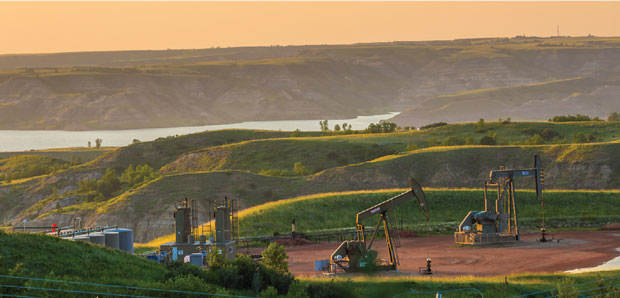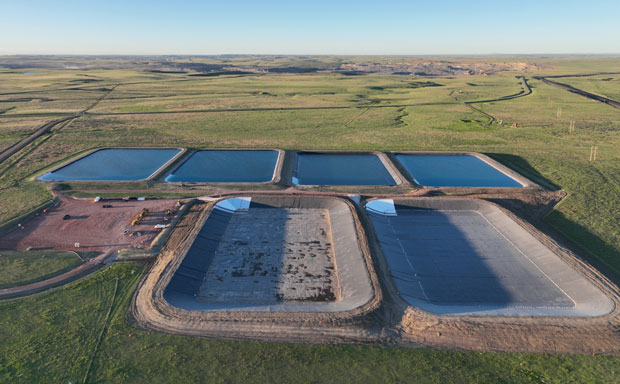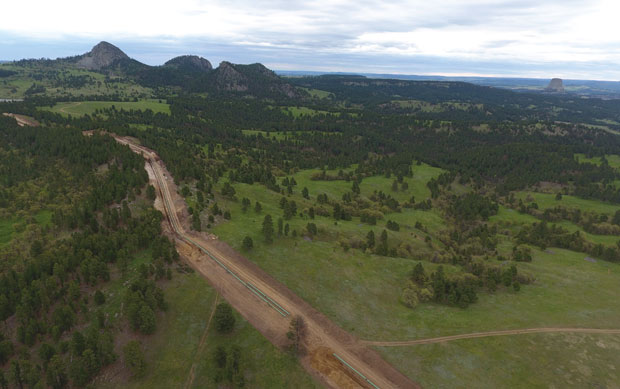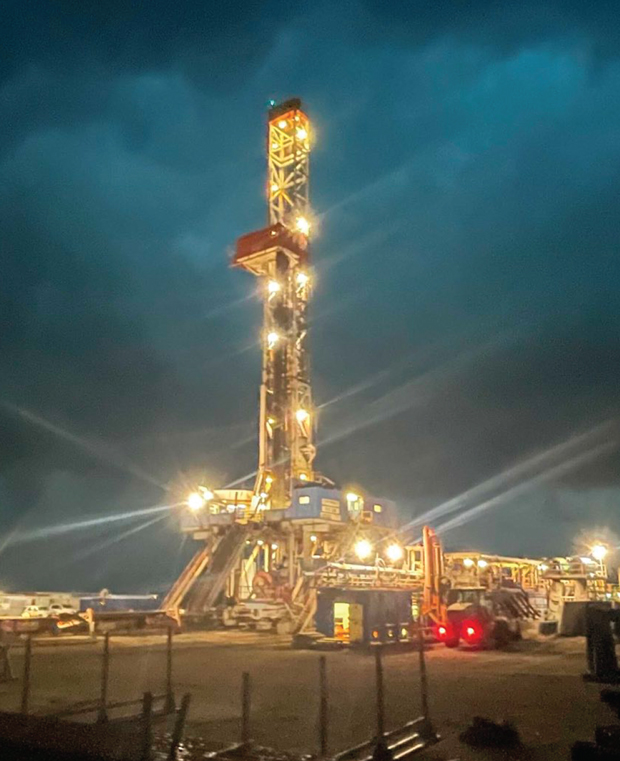
Williston And Powder River Top Mix Of Basins, Plays Targeted By Rockies Operators
By Danny Boyd
The Williston and Powder River basins continue to be the stars of the oil and gas show in the rugged Rocky Mountains, and despite challenges in the form of topography, stratigraphy and regulations–exacerbated by low natural gas prices–public and private players march ahead with acquisitions and developmental work to establish positions, prove up existing acreage and expand into other proven Rockies plays.
With larger operators’ sights primarily fixed on horizontal activity in Williston, Powder River and Denver-Julesburg tight oil horizons, companies of all sizes are taking advantages of opportunities to develop liquids-rich natural gas reserves in Utah’s Uinta Basin and anticipating the possibility of a resurgence in demand for the Mancos Shale dry gas in the San Juan Basin amid growth in U.S. liquified natural gas exports and forecasts for higher gas demand to feed more domestic power consumption.
Still, acquisitions among big players in the Williston continue to grab the headlines even as smaller, established companies drill exploratory and development wells in North Dakota and Montana and anticipate opportunities to pick up acreage as larger companies divest of noncore assets. The Williston is the most active basin, but given a 5,000-foot stacked pay column with 14 proven horizons, the Powder River has the potential to become a new unconventional resource play headliner.
Devon Energy solidified its position as one of the Rockies’ top producers and leaseholders this summer with a $5 billion acquisition of Grayson Mill Energy, adding 307,000 net acres in North Dakota with 500 undrilled Bakken and Three Forks locations along with 300 hydraulic refracturing candidates.
Devon Energy Corp. is one of the Rockies’ top players, and earlier this summer it solidified that position by announcing a $5 billion acquisition of Grayson Mill Energy LLC, which is anticipated to add 307,000 net acres in North Dakota, including 500 undrilled Bakken and Three Forks locations and 300 high-quality hydraulic refracturing candidates, according to Chief Operating Officer Clay Gaspar.
The acquisition is expected to boost Devon’s companywide crude production to 375,000 barrels a day and total production to 765,000 barrels of oil equivalent a day across a portfolio that includes positions in the Delaware, Eagle Ford and Anadarko basins. After closing on the Grayson Mill deal, Devon will rank among the five largest U.S. oil producers, Chief Executive Officer Rick Muncrief points out.
“These assets are an excellent addition to our portfolio, fitting perfectly within our broader strategic framework to accumulate resource and grow oil-weighted production in the best parts of the top U.S. shale plays,” he says.
The acquisition also will benefit Devon through stronger margins thanks to Grayson Mill’s midstream infrastructure ownership, which includes 950 miles of gathering systems and an extensive network of disposal wells and crude storage terminals. With enhanced scale in the basin, Devon expects to realize up to $50 million in average annual cash flow savings from operating efficiencies and marketing synergies, Muncrief told investors in an earnings call.
The company expects to run a consistent three-rig drilling program in the Williston in 2025 and plans to maintain production on the Grayson Mill assets at about 100,000 boe/d with a combination of two- and three-mile laterals, supplemented by tactical refracs to enhance base production, Gaspar details.
Meanwhile across the state line to the west, Devon is helping lead the industry’s charge into high-upside tight formations in the Powder River, focusing on fully assessing the potential of the Niobrara formation in Wyoming, Gaspar reports.
A focus on subsurface technical applications has resulted in higher well productivities over the past 18 months, he says. Next steps include efforts to refine development spacing across an expansive fairway and continue to reduce well costs as work shifts to more developmental drilling.
“We have identified material improvements that are shaping up to be needle movers for this important future development for Devon,” Gaspar comments.
Powder River Program
Anschutz Exploration Corp. was one of the first operators to begin testing unconventional resource development concepts targeting the various Powder River Basin formations. Anschutz has matured its strategy to the point where it now is aggressively leveraging full-scale development of the Niobrara, Parkman and Sussex, and is in the early stages of a Mowry program on an industry-leading 450,000 net acres in the basin, says Chief Executive Officer Joseph DeDominic.
“We have the timeframe and resources to work projects and make them successful and profitable, and that is what we have been doing in the PRB since 2015,” he says.
Anschutz Exploration is aggressively leveraging a full-scale development program in the Powder River Basin targeting the Niobrara, Parkman and Sussex formations, and also is in the early stages of a Mowry program on an industry-leading 450,000 net acres in basin.
Founded by noted entrepreneur Philip Anschutz, the privately held company also has assets in Colorado’s Piceance Basin and Utah’s Uinta, but its chief focus is in Wyoming’s Campbell, Converse and Johnson counties, where about 70 wells are planned this year from three active drilling rigs and one frac spread.
The 2024 drilling campaign follows 91 new wells in the PRB last year. Since 2021, the Denver-headquartered company has grown output by 43,000 boe/d and now accounts for roughly 30% of all Powder River Basin production, DeDominic estimates. This year, company production will average an estimated 53,000 boe/d with 64% crude oil.
More than half of Anschutz’s new PRB wells are in the Niobrara, which along with the similarly kerogen-rich Mowry, has fed the shallower sandstones with hydrocarbons over the eons, he explains. The Upper Niobrara includes 100-120 feet of potential pay and the Lower Niobrara 40-50 feet on average, DeDominic says.
Vertical depth to the Niobrara is about 10,000 feet on average, and Anschutz is testing 2.5-mile laterals in the bench as it refines engineering on longer horizontals. Some three-mile laterals will be drilled next year, he adds.
The average peak IP-30 rate for the most recent 29 Niobrara wells completed by the company in 2024 is 1,250 boe/d with an average of 80% oil, DeDominic says. The Mowry appraisal program includes economic assessments and well spacing experiments, and work on targeting is resulting in improved drilling and completion efficiencies.
Up and down the active stratigraphic column, the company says it continues to benefit from improving efficiencies. Some Niobrara wells have been drilled in 10 days and completion optimization has allowed Anschutz to achieve the same results at lower costs, DeDominic remarks.
Challenging topography and stipulations in the region come with federal encumbrances, DeDominic points out. Despite the law allowing for lease auctions, the U.S. Bureau of Land Management currently is not holding regular Powder River lease sales, although Anschutz and others are nominating many tracts. In the meantime, land swaps are helping the company to consolidate its position, he says.
Although crude production from the Williston farther north can create negative price differentials, adequate crude takeaway in the Powder River is providing some price flexibility with options to ship to the Guernsey, Wy. crude oil hub or to Cushing, Ok., through midstream providers, DeDominic says.
Red Wing Creek Field
Other Rockies players continue to rely on tried-and-true unconventional plays to deliver crude to market. Longtime Rockies independent True Oil LLC is drilling exploratory and developmental wells in North Dakota and Wyoming while affiliated enterprises in the True Companies family expand oil and gas services and other business interests. Casper, Wy.-based True Oil also operates in the Niobrara trend in the Denver-Julesburg Basin in Colorado as well as in other northern Rockies basins.
In August, True Oil was wrapping up completion work on two Three Forks wells in McKenzie County, N.D., says Dave True, an executive partner along with his brother Hank, whose companies sprang from father H.A. True’s 1948 acquisition of a drilling company.
True Oil LLC operates assets in Colorado, Wyoming and North Dakota. It is currently drilling exploratory and developmental wells in North Dakota and Wyoming, including 3-D-seismic-guided horizontal drilling at its Red Wing Creek Field targeting the Mission Canyon Limestone.
The company also has two additional McKenzie County wells planned this year at the Red Wing Creek Field, which True Oil discovered in 1972.
Early on, a test well at Red Wing targeting the Ordovician-aged Red River formation instead tapped into oil flows from the younger Mississippian-age Mission Canyon Limestone. The event marked the discovery of the Mission Canyon astrobleme, a subsurface crater caused by a large ancient meteorite hitting the earth’s surface and pushing up what would become an oil-rich rim around the massive geological rebound mound.
“We were drilling ahead and all of a sudden started seeing oil on pits way too early,” recalls True, a board member at the Petroleum Association of Wyoming. “Instead of being at 12,000 feet, we were at only 6,000 feet. We were right on top of the astrobleme and ended up with multiple thousands of feet of pay there.”
Lateral lengths can vary widely because of the rim’s circular nature, making 3-D seismic data paramount to determining lateral placement and length, which can vary from one-third of a mile to 2.5 miles. However, wells drilled off the rim can tap into an “ocean of water.” Successful wells can be completed simply with acid, True says.
In the Powder River, True plans two Turner test wells in Weston County, Wy., and will add others down the road, he elaborates. The company has nonoperating interests in New Mexico and Kansas, and oil and gas service affiliates active throughout the region, including True Drilling, Toolpushers Supply, Black Hills Trucking, product marketing wholesaler Equitable Oil, Bridger Pipeline, Flowstate and Eighty-Eight Oil LLC, which operates the Gurnsey crude hub.
The family also operates a crude rail facility immediately west of Fort Laramie, Wy., and has partnered with a Uinta producer to transport waxy crude from Utah to Fort Laramie for blending with Bakken sweet for transportation to Guernsey and other sales points. The group also is eyeing expansion into carbon sequestration and transportation, True says, to help Rockies producers eying enhanced oil recovery.
Uinta Basin Additions
While the Williston and Powder River basins get the lion’s share of attention in the Rockies, operators also are taking advantage of other opportunities in the region.
SM Energy Co. is moving into the core of Utah’s Uinta Basin with the pending acquisition of XCL Resources and by additionally exercising an option to add adjacent assets. Together, the transactions will net the Denver-headquartered company 63,300 acres, 465 drilling locations and 44,000 boe/d in production.
“We have identified development potential across as many as 17 benches within nearly 4,000 feet of hydrocarbon column, which ranks among the largest over-pressured hydrocarbon columns in U.S. producing basins,” says President and CEO Herbert Vogel.
A publicly held player with more than 110,000 acres in the Midland Basin and 155,000 in the Eagle Ford, SM is paying $2 billion for 37,200 net operated acres, or 80% of XCL’s overall Uinta position. Nonoperating partner, Northern Oil & Gas Inc., obtains the remaining 20% for $500 million. The deal is expected to close in October.
Production is 88% oil, and wells include a breakeven range from $43 to $57/bbl, Vogel relates. The XCL transaction increases overall SM oil production by 45% to 195,000 boe/d with an oil mix greater than 50%.
On the adjoining, optioned position, SM will pay $70 million for 26,100 net acres. The area includes 75 net drilling locations, and oil constitutes 75% of 1,000 boe/d output.
In the Uinta core, drilling, completion and equipment costs are similar to SM’s operations in the Midland and the South Texas Austin Chalk plays, in the low $800/lateral-foot range, Vogel says. Oil production from the Uinta Upper and Lower cubes also is competitive with both.
In the Utah basin, there are already more than 800 horizontal wells in the six Lower Cube benches and more than 15 from multiple operators in emerging Upper Cube, which includes the Lower Garden Gulch, the Upper/Middle/Lower Douglas Creek and the Black Shale.
Produced oil from both verify development independence, Vogel says, and SM Energy is poised to de-risk horizontal potential in deeper targets demonstrated by historical vertical production with test wells in progress.
“We also understand that the waxy nature is in high demand by refiners and upper-end lubricant markets, Vogel remarks. “Lease operating expense runs slightly less in the Midland Basin largely due to less water handling. Put all those together, and we will be able to deliver strong margin per boe produced.”
Williston Basin Focus
With 32,177 net acres in the Williston Basin, Prima Exploration Inc. is extending laterals, improving efficiencies and keeping an eye out for potential acreage additions amid basin consolidation, says CEO Brian Law.
“We are hopeful there will be more opportunities in the future after some of these large merging companies consider divesting noncore assets,” Law comments.
Prima Exploration Inc. is undertaking a three-mile lateral drilling program in the Middle Bakken and Three Forks in the Williston Basin, as it keeps an eye out for potential acreage additions amid ongoing basin consolidation.
Prima also has properties in the Powder River and Delaware basins, but the focus is chiefly on the Williston, where oil accounts for 85% of its gross production from 53 operated wells primarily in North Dakota’s Williams, Divide and McKenzie counties, and Richland and Roosevelt counties in Montana.
The 44-year-old Denver-based company has plenty of room to run with a well inventory for two-mile laterals of 76 in the Middle Bakken and 56 in the Three Forks, Law details.
Prima has drilled an average of six wells annually in recent years, and this year has launched its first three-mile lateral program with two planned wells in western North Dakota and two in eastern Montana, all north of the Missouri River, he says.
Active in the Williston since the mid-1990s, the company will remain committed to it, partly because the basin has substantially less federal acreage and a more industry-friendly regulatory environment than other basins in the Rockies, Law comments.
In the Powder River, Prima operates the federal Table Mountain Unit in Johnson County, Wy., producing from the Shannon with a mix of conventional and horizontal wells on waterflood. The company says it is keeping an eye out as larger neighbors effectively de-risk the Niobrara and Mowry next to a Prima position that includes 50 potential locations.
“These source rock reservoirs have the potential to transform the Powder River into a world class basin,” Law concludes.
San Juan Mancos Wells
Through common ownership with Epic Energy LLC of Aztec, N.M., Walsh Engineering & Production is adding people and expertise to prepare for growth in the San Juan Basin from an anticipated renewed interest in natural gas from the Mancos Shale, says Walsh President John Thompson.
Nationally, soft natural gas prices and drilling eventually will give way to the need for more gas supply, and for operators with assets in the Mancos and other San Juan pays that means the possibility of connecting to a planned Mexico LNG terminal that will sell gas to the Pacific Rim, Thompson says. Sempra Infrastructure’s planned liquefaction project at Energía Costa Azul is only 60 miles south of San Diego and pipelines from San Juan, which supply California, already connect to system that will feed the facility.
In addition, a representative for a Salt Lake City artificial intelligence data center planning to build its own natural-gas fired power plant recently called about potential gas supplies, Thompson divulges.
Although the majors and large public independents have shifted away from the San Juan, newcomers and committed players also will benefit from growing gas demand for power generation in general, including in California, he suggests.
To prepare for more business and expand contract operating and engineering services for Epic and other independents, Walsh in recent years has grown from a handful of employees to about 100.
“Being a low-cost operator has definitely been the name of the game, and we think we are poised to hopefully be in the right spot here,” Thompson says.
He says about 30 Mancos Shale wells have been drilled across the northern San Juan. Epic, which has 483 wells on 64,772 net acres, is partnering with NueVida Resources of Dallas, which put together a position in La Plata County, Co., and in August was completing two Mancos wells with plug-and-perf, slickwater fracturing designs.
Other Mancos wells have been drilled with strong results, says Thompson, pointing to Logos Resources’ Rosa Unit No. 64H in Rio Arriba County, N.M., which last year posted an IP-30 of slightly less than 25 million cubic feet a day.
The shale is located at a depth of 6,500-6,800 feet, with laterals ranging from 1.5 to 2.0 miles with recoverable reserves as high as 20 billion cubic feet. Basinwide, about 50 trillion cubic feet of gas has been recovered, with the possibility of that much more being produced in the future, Thompson says.
“We are on the front edge of the development of the dry gas Mancos play, which is going to be another historic chapter for the San Juan Basin,” he states.
For other great articles about exploration, drilling, completions and production, subscribe to The American Oil & Gas Reporter and bookmark www.aogr.com.



















